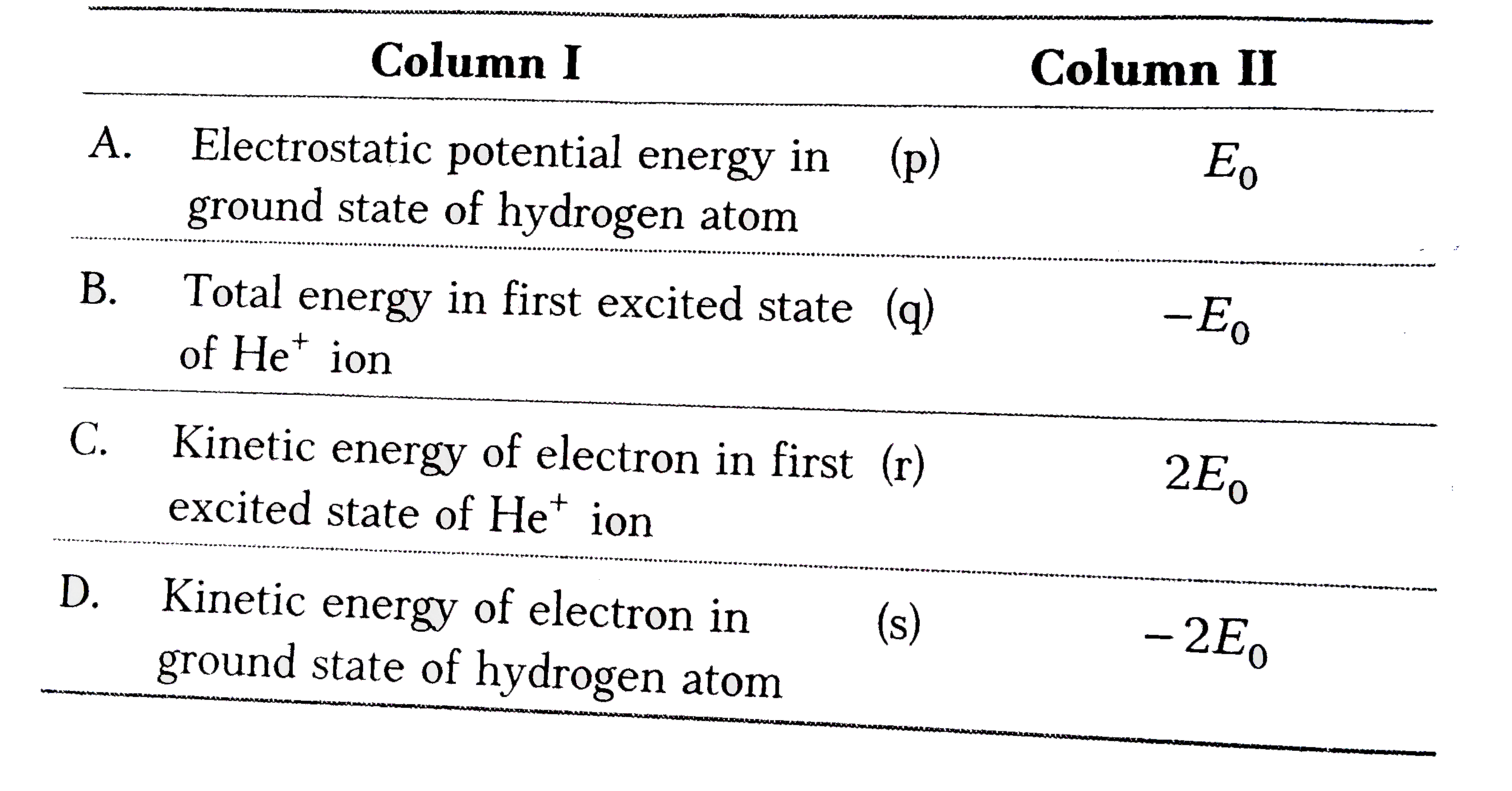The minimum kinetic energy required for ionization of a hydrogen atom is in case electron is collided with hydrogen atom , it is if the the hydrogen ion is collided and when helium ion collided . Then.
The correct Answer is:C
To solve the problem regarding the minimum kinetic energy required for the ionization of a hydrogen atom when different particles collide with it, we will analyze the situation step by step.
Step 1: Understanding Ionization Energy
The ionization energy is the minimum energy required to remove an electron from an atom. For a hydrogen atom, the ionization energy from its ground state is approximately 13.6 eV.
Step 2: Identifying the Particles
We have three scenarios based on the colliding particles:
- E1: Minimum kinetic energy required when an electron collides with a hydrogen atom.
- E2: Minimum kinetic energy required when a hydrogen ion (H⁺) collides with a hydrogen atom.
- E3: Minimum kinetic energy required when a helium ion (He²⁺) collides with a hydrogen atom.
Step 3: Analyzing E1 (Electron Collision)
When an electron collides with a hydrogen atom, it needs to overcome the ionization energy of 13.6 eV. Therefore, the minimum kinetic energy required, E1, is:
E1=13.6 eV
Step 4: Analyzing E2 (Hydrogen Ion Collision)
A hydrogen ion (H⁺) has a positive charge and can attract the electron more strongly than a neutral electron. Since it has a charge of +1 (Z = 1), the energy required to ionize the hydrogen atom will be less than that required for an electron. However, it still needs to overcome the ionization energy, so:
E2>E1
But it will be less than the energy required for a helium ion.
Step 5: Analyzing E3 (Helium Ion Collision)
A helium ion (He²⁺) has a charge of +2 (Z = 2) and will exert a stronger attractive force on the electron compared to both the electron and the hydrogen ion. Thus, it will require more energy to ionize the hydrogen atom:
E3>E2
Step 6: Conclusion
From the analysis above, we can summarize the relationships between the energies:
E1<E2<E3
Thus, the correct order of minimum kinetic energies required for ionization is:
- E1 (electron collision) is the least.
- E2 (hydrogen ion collision) is intermediate.
- E3 (helium ion collision) is the greatest.
Final Answer
The correct order is:
E1<E2<E3
The ionization energy is the minimum energy required to remove an electron from an atom. For a hydrogen atom, the ionization energy from its ground state is approximately 13.6 eV.
We have three scenarios based on the colliding particles:
- E1: Minimum kinetic energy required when an electron collides with a hydrogen atom.
- E2: Minimum kinetic energy required when a hydrogen ion (H⁺) collides with a hydrogen atom.
- E3: Minimum kinetic energy required when a helium ion (He²⁺) collides with a hydrogen atom.
When an electron collides with a hydrogen atom, it needs to overcome the ionization energy of 13.6 eV. Therefore, the minimum kinetic energy required, E1, is:
E1=13.6 eV
A hydrogen ion (H⁺) has a positive charge and can attract the electron more strongly than a neutral electron. Since it has a charge of +1 (Z = 1), the energy required to ionize the hydrogen atom will be less than that required for an electron. However, it still needs to overcome the ionization energy, so:
E2>E1
But it will be less than the energy required for a helium ion.
A helium ion (He²⁺) has a charge of +2 (Z = 2) and will exert a stronger attractive force on the electron compared to both the electron and the hydrogen ion. Thus, it will require more energy to ionize the hydrogen atom:
E3>E2
From the analysis above, we can summarize the relationships between the energies:
E1<E2<E3
- E1 (electron collision) is the least.
- E2 (hydrogen ion collision) is intermediate.
- E3 (helium ion collision) is the greatest.
The correct order is:
E1<E2<E3
Topper's Solved these Questions
- BOOK - CENGAGE PHYSICS ENGLISHCHAPTER - ATOMIC PHYSICSEXERCISE - Multiple Correct13videos
ATOMIC PHYSICS
- BOOK - CENGAGE PHYSICS ENGLISHCHAPTER - ATOMIC PHYSICSEXERCISE - Linked Comprehension62videos
ATOMIC PHYSICS
- BOOK - CENGAGE PHYSICS ENGLISHCHAPTER - ATOMIC PHYSICSEXERCISE - Subject17videos
ATOMIC PHYSICS
- BOOK - CENGAGE PHYSICS ENGLISHCHAPTER - ALTERNATING CURRENTEXERCISE - Single Correct10videos
ALTERNATING CURRENT
- BOOK - CENGAGE PHYSICS ENGLISHCHAPTER - CAPACITOR AND CAPACITANCEEXERCISE - Integer5videos
CAPACITOR AND CAPACITANCE
Similar Questions
Knowledge Check
- Question 1 - Select One
the energy required to excite an electron in hydrogen atom to its first excited state is
A8.5eVB10.2eVC12.7eVD13.6eV - Question 2 - Select One
If 13.6eV energy is required to separate a hydrogen atom into a proton and an electron, then the orbital radius of electron in a hydrogen atom is
A5.3×10−11mB4.3×10−11mC6.3×10−11mD7.3×10−11m
The ionisation potential of hydrogen atom is 13.6eV The energy required to remve as electron in the n=2 state of the hydrogen atom is
View SolutionThe ionisation potential of hydrogen atom is 13.6eV. The energy required to remove an electron in the n=2 state of the hydrogen atom is
View SolutionThe total energy (E) of the electron is an orbit of radius r in hydrogen atom is
View SolutionGround state energy of hydrogen atom is E0 . Match the following two columns.
 View Solution
View SolutionIf 13.6eV energy is required to ionized the hydrogen atom then the energy required to ionize the hydrogen atom , then the energy required to remove an electron from n=2 is
View SolutionIf 13.6eV energy is required to ionized the hydrogen atom then the energy required to ionize the hydrogen atom , then the energy required to remove an electron from n=2 is
View Solution

